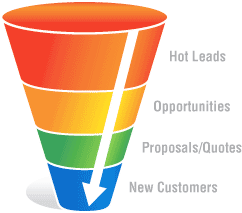5 Tips on How to Convert More Leads Into Sales
As a marketing agency that focuses on helping businesses grow, the most common request we get is to help businesses with their lead generation.
4 min read
Olivia Walls
:
Jun 30, 2022 10:09:28 AM

A sales funnel and sales strategy have long gone together like peanut butter and jelly, macaroni and cheese, and bacon and eggs.
The problem is that for many businesses, the recipe is changing. The sales landscape is evolving and today’s modern buyer doesn’t follow the age-old recipe that you’ve always been able to count on.
Today’s potential buyers now have a number of ways to get information on the product or service they need, and each buyer’s journey looks different. That means the traditional sales funnel strategy that teams have relied on for decades no longer is relevant.
Instead, the traditional funnel now looks like a flywheel … one that puts customers at the center.
A sales funnel describes the path your prospects take on their customer journeys. It includes the stages of becoming a customer, from hot leads to becoming new customers.

However, this traditional sales funnel places customers as the output at the bottom of the funnel. It also doesn’t take into consideration that times have changed and people are making decisions differently.
A great example is video marketing, which has become an extremely effective inbound marketing tool to provide valuable content to prospects. Nearly 94% of people surveyed report watching explainer videos to learn more about a product and brand before they buy the product. That’s BEFORE they ever enter into your funnel. Of those, 84% reported being swayed to make a purchase.
Potential clients also now rely on other forms of third-party advice, including review sites, friends or mentions of your service on social media … again, before they ever enter your sales process. If they don’t enter your sales funnel, then you have little chance of improving your conversion rates.
Because of the way they are designed, funnels do not incorporate the momentum that you build and do not evolve when lead generation strategies begin to slow down.
The flywheel incorporates the same components as a sales funnel but the main difference is that it places customers at the center … creating a less linear approach to your lead generation activities.
The flywheel has three main components, Attract, Engage and Delight, and looks like this:
.png?width=400&name=flywheel-inbound-method-lifecycles%20(1).png)
The Attract phase of the flywheel focuses on “drawing in the right people with valuable content and conversations that establish you as a trusted advisor with whom they want to engage,” according to Hubspot.
Here, you are looking to attract the right traffic to your company website. The right traffic is based on your buyer persona or personas, which are fictionalized representations of your ideal customers based on real data about customer demographics and online behavior.
To attract buyer personas to your site, you use a cache of tools that strategically generate qualified leads from your target audience, including:
Through great content marketing, potential customers receive valuable pieces of information that they perceive as helpful as they try to solve a specific problem or fulfill a need. Content offers include items such as eBooks, editorial content, checklists and analysis reports, etc. These types of content are offered in the Attract stage of the buyer's journey.
Content offers should be targeted and focus on one service or product rather than each and every service your company offers. They should also have their own landing pages on your website. This dedicated landing page allows you to capture information about the prospect in exchange for the offer. To get potential customers to this landing page, use calls-to-action on your other website pages or content that you create (such as blogs).
The Engage phase focuses on “presenting insights and solutions that align with their pain points and goals, so they are more likely to buy from you,” according to Hubspot. Think of items like videos, podcasts, expert guides and comparison charts or whitepapers.
This stage is when you engage with potential clients so that they will want to develop a long-term relationship with you. In the early part of this stage, you can develop prospects or visitors into leads by typically getting simple contact information like their email addresses. Later, you can request more information.
Some tools to help you in this stage include:
The Delight phase emphasizes nurturing customers to expect assistance at any point, as well as promotes high customer retention and long-term relationships with clients.
Tools to use in this stage include:
Make sure you interact with current and prospective customers through these digital marketing efforts when opportunities arise, such as if someone asks a question about one of your services or products on social media.
The flywheel is a more effective sales strategy tool because it is more comprehensive and represents the fact that each action a team member takes impacts another action. When funnels do not incorporate any momentum or reflect slowdowns, you miss out on opportunities to improve your internal processes to make your flywheel spin faster.
Like any good marketing strategy, it’s critical to know what’s working and what isn’t, and then adjust.
The amount of energy your flywheel contains depends on three types of forces:
As you implement strategies that ramp up your lead generation efforts, your flywheel speeds up. When these strategies are effective, there is little friction because you are removing any barriers to increasing your flywheel speed.
On the other hand, common issues like poor internal processes and a lack of communication between teams can slow down your flywheel. When you remove these friction points, your flywheel will continue to spin and grow larger as you create more promoters of your business.
It’s also important to note that as you map out your flywheel, it can look very different than another company. That customized approach to your business helps you develop strategies specific to your goals.
Keep in mind that no flywheel is set in stone. Whatever marketing funnel or flywheel you develop, you must track the process with analytics (such as Google analytics) to see what roadblocks are preventing you from being successful … and then adjust your strategies to overcome these barriers.
As you develop a flywheel and adjust accordingly, you are building a community of customers who then want to help other customers like them. In other words, you are leveraging current customers to attract and engage the new prospects that your sales reps covet.

As a marketing agency that focuses on helping businesses grow, the most common request we get is to help businesses with their lead generation.

Are you struggling to turn your B2B leads into sales? Does marketing blame sales for the problem or does sales blame marketing? In either event,...

The B2B sales strategy you build will determine whether your strategic plans fully launch or fully fail.